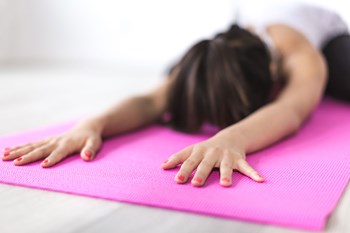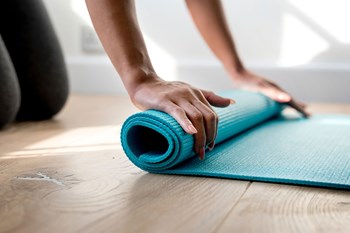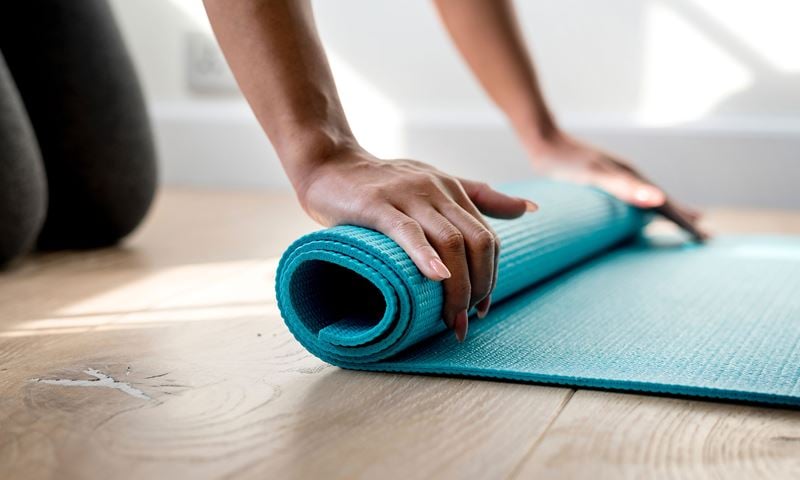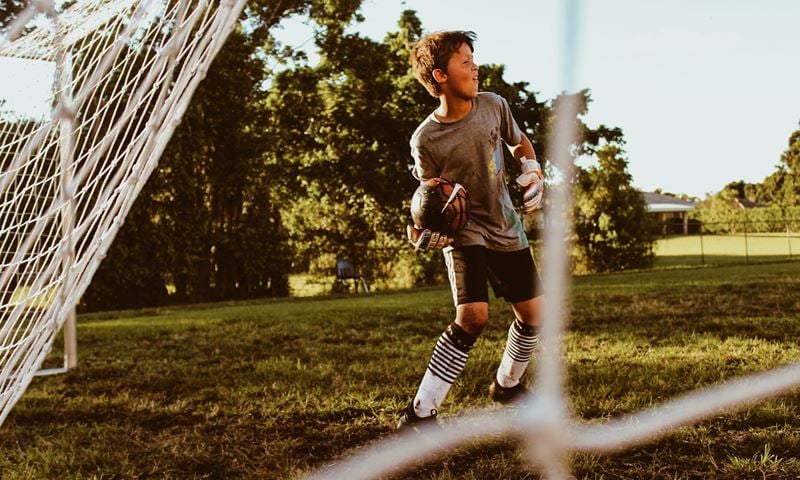Article written by Jill Harris, yoga teacher and yoga therapist
Taking time out for our own health and wellbeing is often the last priority on the long list of what needs to be done in a day.
When we start to ignore our own wellness, we suffer more than physically. Our mind needs to stay healthy for us to live positive and happy lives.
 What is yoga?
What is yoga?
Yoga is a discipline that directs awareness inwards to our self. Much more than just a series of postures (asanas), it also incorporates specific breath techniques (pranayama), chant (mantra), visualisation (bhavana), meditation and other tools aimed at withdrawing from the distractions of ‘outside’ to listening to our self ‘inside’.
What are the benefits of doing yoga?
Taking time to step onto the yoga mat can be the circuit breaker between that long list of obligations that we encounter every day and caring for our own health. It can give us a chance to ‘be’ rather than ‘do’.
On a physical level, yoga provides movement for our bodies, building strength and flexibility and often alleviating patterns we are accumulating from activities like sitting for long periods.
But at the level of our mind, yoga gives the gift of allowing us to relax and let go of effort and stress, particularly during restorative poses that release tension in body and mind. As the mind relaxes, other systems in the body such as the digestive, nervous and respiratory can begin to work more efficiently.
With regular practice we can begin to make clearer decisions and form a deeper understanding of what is right for us.
The value of conscious breathing
Conditions like anxiety and depression can lead to a very short breath pattern. Learning how to breathe to our full potential is paramount.
 Anxiety provokes a stress response in the body that creates ‘holding’ patterns. One of these can be in our breath. Our body will have more vitality and our mind will experience greater clarity if we have a full and easeful breath.
Anxiety provokes a stress response in the body that creates ‘holding’ patterns. One of these can be in our breath. Our body will have more vitality and our mind will experience greater clarity if we have a full and easeful breath.
Using the nostrils rather than the mouth to breathe is important. This sustains energy for the places in the body that need it! Tiredness is a common symptom of mouth breathing.
Calming breath exercise
- Lying comfortably, begin to connect with inhale and exhale through the nostrils if possible. Breathe smoothly and evenly gradually lengthening your breath.
- Establish inhale and exhale to a length of three or four seconds keeping a smooth and comfortable breath.
- Once you have established this breath count, begin to lengthen the exhale gradually – so to four or five seconds for a couple of breaths, then six seconds if possible and so on. You can extend the exhalation as long as it feels comfortable staying with the counting. Keep your inhalation at your starting number three or four seconds.
The longer the exhalation the more calming effect you are bringing to body and mind.
Yoga Postures for Restorative Benefit
Below are some postures that can assist with relaxing the nervous system and releasing tension in our body.
Apanasana (lower abdomen posture)
As the name suggests this pose focuses on the belly and is excellent for releasing tension in the lower abdomen. Because of this it is a wonderful pacifying pose for the nervous system.
Lie on your back with the knees bent and drawn in towards your torso, hands resting on the front of the knees, elbows soft. As you inhale the breath, move the knees slowly away from the torso just to where the arms straighten (feet staying relaxed towards your buttocks). On exhale, gently draw the navel towards the spine allowing the legs to come back in towards the chest. Repeat slowly for a minimum of eight breaths.
Supta Baddha Konasana (lying bound angle pose)
Lie on your back with your knees bent and the ankles/knees placed together. Open knees wide and bring foot soles together. If you find this challenging on the hips support the sides of the thighs with some rolled up blankets or cushions. As you inhale the breath raise the arms overhead, allowing hands to arrive on the floor (or a support) behind you. Take a long full inhale from the top of the lungs travelling down to the belly and allowing exhalation to move naturally up and out. Stay and breathe for a minimum of eight breaths.
Crouch back towards the heels, arms stretched forward, gaze towards the floor.
As you inhale, move the body forward onto all fours, look forward slightly with a gentle opening of the chin. Feel the chest softly lift forward and the upper back gently arch.
As you begin to exhale, tuck the chin down and draw the bottom back towards the heels. The spine should stay long rather than round as you go back. To assist this movement, imagine drawing the navel gently back towards the spine as you exhale. Repeat for a minimum of eight breaths.
Savasana (corpse pose) with support
Lie on your back with your knees slightly bent and supported by a bolster or rolled up blanket/towel. This relieves any pressure on the lower back and allows for a more comfortable rest where the mind can fully relax. Support the head with a cushion or folded blanket if you feel your throat opening or head tilting too far back. Let the arms lie slightly out to the sides with the palms turn up, fingers relaxed. Take 12 deep breaths visualising inhale moving a nourishing energy into the body and exhale letting go of effort from the day.
Deakin University, in partnership with Barwon Health and supported by GMHBA are currently examining the impact of yoga in addition to psychological treatment for adults with depression and anxiety in a novel study being conducted in Geelong. The research team consisting of mental health clinicians, yoga teachers and academics with an interest in complementary approaches such as yoga, are enthusiastic about the potential benefits of yoga alongside traditional psychological approaches such as Cognitive Behavioural Therapy in the treatment of depression and anxiety. Click here for further information.



